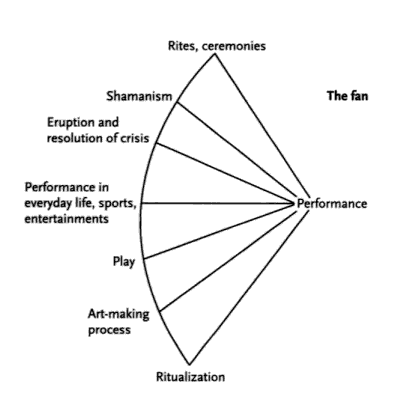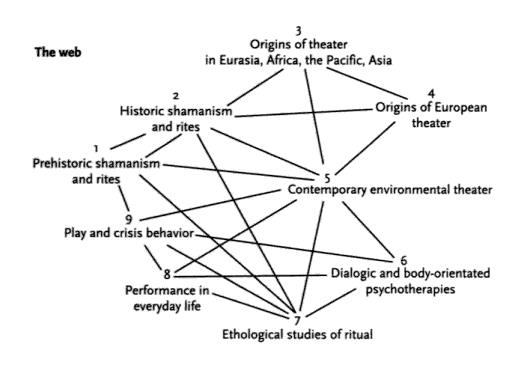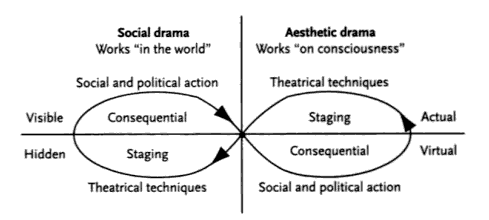Richard Schechner: Performance Theory

Schechner's Fan
Schechner’s perspective on performance is broad and inclusive. He sees it as including much more than theatre, but along an entire spectrum, which ranges from everyday life to rituals and art. Two perspectives on performance are the models of the web and the fan. Schechner is heavily influenced by Victor Turner, who treats performance and play as the “as if”. Within the context of performance, the imaginary becomes real, and the “as if” is equivalent to the “is”. Schechner’s goal is to unite all applications of performance under one theory which is inclusive of its many applications. Much of this text is influenced by his travels to Australia and Southeast Asia, and one aim is to reincorporate the rituals of the New Guinea tribesmen, Australian Aborigines, the Balinese, and many others, with the practices of both classical and modern theatre. Schechner was influenced by Goffman as well, acknowledging the performances of everyday life.

Schechner's Web
To discuss performance, Schechner uses two models, the web and the fan. The fan presents performance as an organized spectrum of categories, and the web reveals the dynamic influences and interconnections. In the fan model, the further one moves up the fan, the more orderly the function of performance, and the lower, the more free and disorderly. The opposing ends of the fan meet, however, as the establishment of a new ritual, which requires a great deal of play and freedom, then becomes a new structure of order. The web model is structured around item (5), which is Schechner’s own background. This is not an indication of bias, but rather perspective, as it his vantage point.
Approaches
Schechner opens this chapter by critiquing an approach to classical Greek theatre, called the Cambridge thesis. This thesis aims to discern the origin of theatre, and the emergence of comedy and tragedy. The Cambridge thesis asserts that both tragedy and comedy evolved from specific rituals. Tragedy comes from the dithyramb, and comedy comes from phallic dances, both of which emerged from some “primal ritual”. This assertion is dubious for a variety of reasons, not least being the absence of any evidence for a primal ritual. Furthermore, rituals do not seem to have much in common with theatre that would indicate the emergence of one from the other. Schechner is not interested in supplying a new origin theory, and is critical of the use of origin theories toward the understanding of theatre. Instead, he is interested in what theatre might have in common with ritual characteristically.
Schechner unites several groups of performance under the same heading: play, games, sports, theatre, and ritual. These share four important qualities: a special ordering of time, a special value attached to objects, non productivity in terms of goods, and rules. (p. 8) Time may be understood as structured in terms of events, which must be completed no matter how long they take. Time may be set, which is an imposed fixed clock time, creating antagonism between the activity and the clock. Time may be symbolic, where the activity represents something happening in a different ordering or flow of time, where time is simply considered differently. While these varying perspectives are distributed among the types of activities described, all are present in digital games. Objects within these performances take on new and special meanings, and their value within the context of the performance may be entirely different than outside. In a ball game, the ball is of crucial and extreme importance, but outside it is inexpensive and has little practical value. The non productivity of performance is in common with what Huizinga and Callois say about games, however Schechner notes some challenges. Performance in theatre has some productive capacity, it fills a theatre house and makes money, sports games are extremely lucrative. However, nothing material is actually produced in the performance itself. Rules apply because performances are activities apart from everyday life. Rules are most notable in the context of games, but also operate in theatre as well. Despite the magnitude of performances, rules are generally held to be the same. The players in a major league baseball game may be better than in a sandlot game, but the rules that govern their conduct are the same nonetheless. Rules are not only designed to tell the players how to play, but how to keep the play space safe against encroachment from the outside.
Play and ritual are seen as opposing ends of performance, but they are still similar. Play is intrinsically motivated, while ritual is extrinsically motivated. The role of freedom is described in positive and negative terms. In performance, constraints are layers, but at the center is always some sort of freedom. The example Schechner gives to illustrate this point is of a theatre performance, where an actor is first confined by the physical space, then by the conventions of theatre, then by the drama or script, then by the instructions from the director, but finally, underneath all of that, the actor has freedom. The relationship between these is what Shechner describes as the axiom of frames. When an outer frame is looser, then the inner frame must be tighter, and vice versa. An example is when a theatrical performance has a very rigid script, then the actor’s freedom within that is more important. Or when the actor has a great deal of freedom, as in improvisational theatre, the conventions used become important.
Drama, Script, Theatre, and Performance
The rituals and scripts used in Paleolithic times were not modes of thinking, but patterns of doing. With Greek theatre, this came to be reversed: action was understood abstractly. Modern theatre is moving to reverse this once again, it loosens the matter of exact presentation, and comes to focus again on doing. Schechner examines the relationship between drama, script, theatre, and performance as concentric rings, with performance as the widest, most encompassing and loosely defined thing on the outside, with drama as the tightest and most delineated thing and is the smallest circle on the inside.
- Drama is the smallest and most intense circle. A drama is independent of the people who carry it, and it may be carried between places and times. Even if the people who perform the drama do not comprehend it, the drama remains preserved.
- Script is all that can be transmitted between places and times. The script is the code of events, and is transmitted between people. The transmitter must know the script and be able to teach it to others.
- Theatre is the event that is enacted by the performers. This is what the performers do during production. The theatre is concrete, present, and immediate. The theatre is meant to be the manifestation of the drama, but it is an articulation and concretization of it.
- Performance is the whole constellation of events that take place in and among the performers and the audience. This is all encompassing and inclusive, containing all of that which is not determined by the script or drama.
Schechner gives another brief summary of the terms: “To summarize thus far: the drama is what the writer writes; the script is the interior map of a particular production; the theatre is the specific set of gestures performed by the performers in any given performance; the performance is the whole event, including audience and performers (technicians, too, anyone who is there).” (p. 87) It is difficult to define performance because of its flexible and permeable boundaries. In public performances, such as celebrations, festivals, and the like, it is easy to shift between being a performer and a spectator.
Another useful framing: performance is “Ritualized behavior conditioned/permeated by play.” (p. 99) This is used to consider performance as a general animal phenomenon. However, Schechner argues that self awareness and cultural transmission are necessary for performance. Play is arguably derived from real life systems, but real systems would not exist without play and freedom to establish them. Schechner borrows from Huizinga in looking at play. Play behavior is derived from hunting and violent/combative activities, but these are also forms of play. The relationship between these activities and play is seen as a sequence of cycles. Playing/hunting leads to ritual/playing, to drama/ritual, to hunting/drama, back to playing/hunting. Rituals and dramas are generally crisis oriented. Crises are moments where balance and order are threatened and must be restored. Although it is arguable that many social rituals exist to maintain order, as opposed to restoring it.
Selective Inattention

Turner's dramatic cycle
Schechner discusses social drama, and borrows a diagram from Victor Turner. I do not know if it appears in Turner’s book, so I am reproducing it here. Schechner’s goal is to take that concept and integrate it with aesthetic drama. Turner’s cycle works in four stages: 1) breach, 2) crisis, 3) redressive action, 4) reintegration. This structure works to maintain social function and consistency. Theatrical tragedy follows this cycle with some degree of accuracy. However, in tragedy, the redressive actions usually wind up leaving the protagonists dead. The “infinity diagram” demonstrates how social drama turns to affect theatrical drama, and social drama also takes on the form of the theatrical.
| Author/Editor | Schechner, Richard |
| Title | Performance Theory |
| Type | book |
| Context | |
| Tags | specials, performance |
| Lookup | Google Scholar, Google Books, Amazon |

